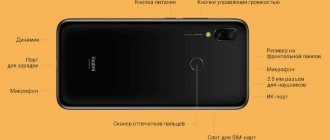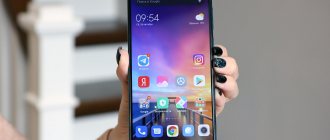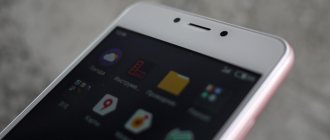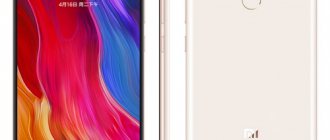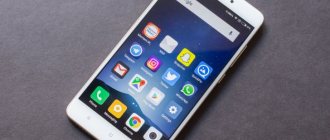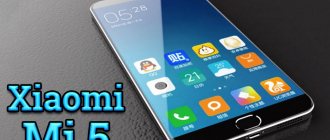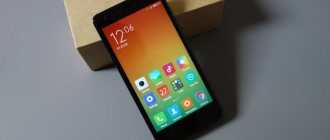What is what
Although the Helio X10 mobile processor was announced last year, it remains top-end to this day. Many mobile flagships with big names use it as a central processor, and the price tag on them rarely falls below $300, which, during the raging dollar exchange rate and the biting prices for flagship electronics, becomes simply an unaffordable amount for many.
But the Chinese are Chinese, and with their small production facilities they quickly adapt to the changing world and sometimes produce luxurious devices with a very attractive price tag. Such devices this year were the very curious Meizu M1 and M2 Note, as well as the Lenovo K3 Note, built on the mid-range processor MT6752 and its younger brother MT6753.
After their release, a serious war broke out in the Chinese domestic market. Each manufacturer considered it their duty to release a smartphone on these processors, producing virtually identical devices with different price tags. Everyone wanted to stand out in their own way until Xiaomi came along. The company did not follow in the footsteps of its competitors and did not make a second Redmi Note based on MT6752 with a price tag of $200. Instead, Xiaomi went further. They stuck the Helio X10 dudes inside, set a price tag for the Chinese version of $120 and sold 800,000 phones on the first day.
The owner of the company was the first to order and delivered these smartphones personally in his Lamborgini right to the door.
Equipment and design
The smartphone came to me for testing in classic branded packaging made from recycled cardboard. The equipment of the Xiaomi Redmi Note 2 smartphone is quite ascetic. In addition to the device itself, in the box you can only find a charger and a manual in Chinese.
Externally, it is an ordinary brick with beveled corners. I liked the design. Quite minimalistic, there is nothing superfluous. At the front, attention is not focused on anything other than the display, and the red-backlit navigation buttons pleasantly complement the image, like a cherry on the cake.
The back cover is matte and feels reminiscent of the old ZTE Nubia Z5s Mini. There is also a peephole for the main 13-megapixel camera with a hole for noise reduction, a corporate logo and an external speaker.
At the top of the screen there is a multi-colored LED for LED notifications, an earpiece and a 5 MP front camera.
The power button and volume rocker are on the right, and the 3.5 jack with an IR port on the top end is where these elements should be. At the bottom left is a micro-USB connector for charging and a hole for a conversational microphone.
Specifications
There are three versions of this smartphone:
- Xiaomi Redmi Note 2 GSM – 16 GB ROM, 2 RAM, Helio X10 with a frequency of 2.0 GHz – only GSM and TD-LTE (no 3G/4G support in CIS networks)
- Xiaomi Redmi Note 2 FDD – 16 GB ROM, 2 RAM, Helio X10 with a frequency of 2.0 GHz – GSM, FDD-LTE, TD-LTE networks (GSM/3G/4G support in CIS networks is available)
- Xiaomi Redmi Note 2 Prime - 32 GB ROM, 2 GB RAM, Helio X10 with a frequency of 2.2 GHz - Work in CIS networks: GSM/3G/4G (there is support for GSM/3G/4G in CIS networks)
I ended up with the second version with 16 GB of ROM and FDD-LTE frequencies. The rest of the technical specifications of Xiaomi Redmi Note 2 look like this:
- IPS LCD screen, 5.5” diagonal, resolution 1920×1080 pixels, 401 ppi
- Mediatek Helio X10 processor (MT6795) eight-core, 2 GHz, Cortex-A53
- PowerVR G6200 550 MHz graphics
- RAM 2 GB
- 16 GB permanent memory + memory card slot
- main camera 13 MP with autofocus and flash, f/2.2, 5 lenses, Samsung sensor, FullHD video recording
- front camera 5 MP, f/2.0, pixel size 1.4 microns
- other fast charging function – 60% charge in half an hour (Quick Charge 2.0), infrared port, OTG support
- battery 3060 mAh
- body materials: plastic, glass
- OS Android 5.0, MIUI V7
- dimensions 152 x 76 x 8.5 mm
- weight 160 grams
Xiaomi Redmi Note 8T: frequently asked questions and all information about the smartphone
We present to you complete information about the Xiaomi Redmi Note 8T smartphone. Does it support NFC, IR, USB OTG, 4K, slow motion video recording, 18W fast charger, etc? In this article we will try to answer all your questions.
We have divided detailed questions and answers on Xiaomi Redmi Note 8T into five main sections: design, display, performance, camera and battery. After reading this FAQ you will know everything about the Redmi Note 8T smartphone.
Design
What is the size of Xiaomi Redmi Note 8T?
161.1 x 75.4 x 8.6 mm
How much does Xiaomi Redmi Note 8T weigh?
200 grams
What case material is used in Xiaomi Redmi Note 8T?
It comes with a glass body.
Does Xiaomi Redmi Note 8T support fingerprint scanner?
Yes, Xiaomi Redmi Note 8T supports a rear-mounted fingerprint sensor.
Is Xiaomi Redmi Note 8T waterproof or water resistant?
No, Xiaomi Redmi Note 8T is not waterproof or water resistant.
Is Xiaomi Redmi Note 8T dustproof?
No, Xiaomi Redmi Note 8T is not dustproof.
Does Xiaomi Redmi Note 8T have a notch?
Yes, it has a tiny teardrop-shaped notch at the top of the display that houses the front camera.
Does Xiaomi Redmi Note 8T come with Gorilla Glass?
Yes, the Xiaomi Redmi Note 8T has Gorilla Glass 5 protection on the front and back, which can protect the device from scratches or minor accidental drops.
Does Xiaomi Redmi Note 8T support Micro USB port or Type-C port?
Xiaomi Redmi Note 8T supports USB Type-C port.
Does Xiaomi Redmi Note 8T support notification light?
No.
What colors is the Xiaomi Redmi Note 8T smartphone available in?
This model comes with some color options such as Starry Blue, Moonlight White and Midnight Grey.
Display
What is the display size of Xiaomi Redmi Note 8T?
Xiaomi Redmi Note 8T comes with a 6.3-inch FHD+ display.
What is the display resolution of Xiaomi Redmi Note 8T?
Xiaomi Redmi Note 8T comes with a resolution of 1080 x 2340 pixels.
What is the screen-to-body ratio of the Xiaomi Redmi Note 8T?
It has a screen-to-body ratio of 80.2%.
What type of display is used in Xiaomi Redmi Note 8T?
Xiaomi Redmi Note 8T supports IPS LCD capacitive touch screen, 16M colors. The display is quite bright and colorful. The text appears clear and easy to read.
Aspect ratio of Xiaomi Redmi Note 8T?
It comes with an aspect ratio of 19.5:9.
Does Xiaomi Redmi Note 8T support automatic or adaptive brightness?
Yes, Xiaomi Redmi Note 8T supports automatic and adaptive brightness.
How many pixels do we get on Xiaomi Redmi Note 8T?
Xiaomi Redmi Note 8T comes with 409 PPI.
Does Xiaomi Redmi Note 8T support Always On Display mode?
No, it does not support this feature.
Does Xiaomi Redmi Note 8T display support HDR10?
No, it does not support HDR10.
Performance
Is Xiaomi Redmi Note 8T a gaming device and can it play heavy games?
No, Xiaomi Redmi Note 8T is not a gaming smartphone. But it can handle light to medium graphics games without any lag or frame drops.
Does Xiaomi Redmi Note 8T support face unlock?
Yes, Xiaomi Redmi Note 8T supports this feature.
What processor is used in Xiaomi Redmi Note 8T?
Xiaomi Redmi Note 8T comes with an Octa-core processor (4×2.0 GHz Kryo 260 Gold and 4×1.8 GHz Kryo 260 Silver).
Which chipset is used in Xiaomi Redmi Note 8T?
It comes with Qualcomm Snapdragon 665 chipset.
What GPU is used in Xiaomi Redmi Note 8T?
It comes with Adreno 610 GPU.
How much RAM do we get on the Xiaomi Redmi Note 8T?
Xiaomi Redmi Note 8T comes with 3GB and 4GB RAM.
How much internal memory do we get on the Xiaomi Redmi Note 8T?
Xiaomi Redmi Note 8T comes with 32GB, 64GB and 128GB of internal storage.
Does Xiaomi Redmi Note 8T have any overheating problems?
The Xiaomi Redmi Note 8T does not have these issues, but it can get a little warm after prolonged use, which is very common in all Android devices.
Can Xiaomi Redmi Note 8T run PUBG Mobile and Fortnite without any problem?
Yes, Xiaomi Redmi Note 8T can run PUBG or Fortnite without any problem, you will not face frame drops while playing these games.
Does Xiaomi Redmi Note 8T support Google Assistant?
Yes, Xiaomi Redmi Note 8T supports Google Assistant.
Does Xiaomi Redmi Note 8T support dual Instagram or Twitter accounts?
Yes, Xiaomi Redmi Note 8T supports two Instagram and Twitter accounts.
Xiaomi Redmi Note 8T freezes after prolonged use?
No, Xiaomi Redmi Note 8T will not slow down or freeze, it can perform everyday tasks very easily.
Is it possible to delete or disable pre-installed apps on Xiaomi Redmi Note 8T?
Yes, you can remove or disable pre-installed apps on your Xiaomi Redmi Note 8T, but not all of them.
Does Xiaomi Redmi Note 8T support video calling?
Yes, Xiaomi Redmi Note 8T supports video calling.
Does Xiaomi Redmi Note 8T support dedicated memory card slot?
Yes, it supports memory card slot. This means that you can insert two SIM cards and a memory card on this smartphone.
Internal storage on Xiaomi Redmi Note 8T can be expanded to?
Internal storage can be expanded up to 256GB.
Which version of Android do we get on the Xiaomi Redmi Note 8T?
It comes with Android 9.0 (Pie) operating system
What UI is used in Xiaomi Redmi Note 8T?
It comes with MIUI 10 out of the box.
Does Xiaomi Redmi Note 8T Mini Jack support 3.5mm audio jack?
Yes, it supports Mini Jack 3.5mm audio jack.
How does the Xiaomi Redmi Note 8T speaker work and what is the sound quality?
The speaker works very well. The sound is loud and clear.
Does Xiaomi Redmi Note 8T support stereo speakers?
No, Xiaomi Redmi Note 8T does not support stereo speakers.
Does Xiaomi Redmi Note 8T support Dolby Atmos?
No, Xiaomi Redmi Note 8T does not support Dolby Atmos.
Does Xiaomi Redmi Note 8T support IR blaster?
Yes, Xiaomi Redmi Note 8T supports IR blaster. This means that you can control your TV or other electronic devices using your mobile phone.
Does Xiaomi Redmi Note 8T support USB OTG?
Yes, Xiaomi Redmi Note 8T supports USB OTG.
Does Xiaomi Redmi Note 8T support FM radio?
Yes, Xiaomi Redmi Note 8T supports FM radio.
Does Xiaomi Redmi Note 8T support virtual reality VR?
Yes, Xiaomi Redmi Note 8T supports VR.
Can Xiaomi Redmi Note 8T play 360 degree videos?
Yes, it can play 360 degree videos.
Can we run VR games or VR apps on Xiaomi Redmi Note 8T?
Yes, it can run VR Games or VR applications.
Does Xiaomi Redmi Note 8T support ambient light sensor?
Yes, Xiaomi Redmi Note 8T supports ambient light sensor.
Does Xiaomi Redmi Note 8T support Gyroscope sensor?
Yes, Xiaomi Redmi Note 8T supports Gyroscope sensor.
Does Xiaomi Redmi Note 8T support accelerometer sensor?
Yes, Xiaomi Redmi Note 8T supports accelerometer sensor.
Does Xiaomi Redmi Note 8T support proximity sensor?
Yes, Xiaomi Redmi Note 8T supports proximity sensor.
Does Xiaomi Redmi Note 8T support Compass sensor?
Yes, Xiaomi Redmi Note 8T supports Compass sensor.
Does Xiaomi Redmi Note 8T support NFC?
Yes, Xiaomi Redmi Note 8T supports NFC.
Does Xiaomi Redmi Note 8T support One Hand interface?
Yes, Xiaomi Redmi Note 8T supports One Hand interface.
Does Xiaomi Redmi Note 8T support split screen function?
Yes, Xiaomi Redmi Note 8T supports split screen feature.
Does Xiaomi Redmi Note 8T support dual apps?
Yes, Xiaomi Redmi Note 8T supports this feature.
Is it possible to root Xiaomi Redmi Note 8T?
Yes, you can root your Xiaomi Redmi Note 8T, but it is not safe as it will void the warranty and your device may turn into a broken phone during the Root process.
Does Xiaomi Redmi Note 8T support 5G or 5G Band connectivity?
No, Xiaomi Redmi Note 8T does not support 5G or 5G Band connectivity.
Does Xiaomi Redmi Note 8T support screen mirroring or chromecast?
Yes, Xiaomi Redmi Note 8T supports screen mirroring or Chromecast feature.
What are the specifications of Xiaomi Redmi Note 8T WLAN?
Wi-Fi 802.11 a/b/g/n/ac
Does Xiaomi Redmi Note 8T support Wifi direct?
Yes, Xiaomi Redmi Note 8T supports Wi-Fi direct.
Does Xiaomi Redmi Note 8T support Hotspot?
Yes, Xiaomi Redmi Note 8T supports Hotspot.
Which Bluetooth version is used in Xiaomi Redmi Note 8T?
It comes with Bluetooth 5.0 version.
Does Xiaomi Redmi Note 8T support Aptx HD?
No, Xiaomi Redmi Note 8T does not support AptX HD.
Does Xiaomi Redmi Note 8T support GPS?
Yes, Xiaomi Redmi Note 8T supports GPS
Does Xiaomi Redmi Note 8T support GALILEO?
No, Xiaomi Redmi Note 8T does not support GALILEO
Does Xiaomi Redmi Note 8T support BDS?
Yes, Xiaomi Redmi Note 8T supports BDS.
What type of SIM card does Xiaomi Redmi Note 8T support?
It supports Nano SIM.
Does Xiaomi Redmi Note 8T EDGE support?
Yes, it supports EDGE.
Does Xiaomi Redmi Note 8T support GPRS?
Yes, it supports GPRS.
Does Xiaomi Redmi Note 8T support call recording?
No, your smartphone does not support this function, but you can use third-party applications for this.
Does Xiaomi Redmi Note 8T support LTE?
Yes, Xiaomi Redmi Note 8T supports LTE.
Does Xiaomi Redmi Note 8T support VoLTE?
Yes, Xiaomi Redmi Note 8T supports VoLTE.
Do both SIM cards on Xiaomi Redmi Note 8T support 4G network at the same time?
Yes, both SIM cards support 4G network at the same time.
Does Xiaomi Redmi Note 8T support dual SIM standby?
Yes, it supports dual SIM standby.
Camera
What are the rear camera sensors of Xiaomi Redmi Note 8T?
Xiaomi Redmi Note 8T comes with a quad-camera setup on the back that has a 48MP main camera with wide lens, 8MP ultra-wide lens, 2MP dedicated macro camera, and 2MP depth sensor camera.
Camera features of Xiaomi Redmi Note 8T?
Xiaomi Redmi Note 8T camera features: autofocus, continuous shooting, digital zoom, geotagging, panorama, HDR, face detection, white balance settings, ISO settings, self-timer.
What is the front camera of Xiaomi Redmi Note 8T?
Xiaomi Redmi Note 8T comes with a 13-megapixel front camera.
Does Xiaomi Redmi Note 8T support night mode?
Yes, it supports night mode.
Does Xiaomi Redmi Note 8T camera support AI (artificial intelligence)?
Yes, the smartphone camera supports AI (artificial intelligence).
Can Xiaomi Redmi Note 8T record 4K video?
Yes, Xiaomi Redmi Note 8T can record 4K videos.
Can Xiaomi Redmi Note 8T record slow motion videos?
Yes, Xiaomi Redmi Note 8T can record slow motion videos at 120fps.
Does Xiaomi Redmi Note 8T support telephoto lens?
No, Xiaomi Redmi Note 8T does not support telephoto lens.
Does Xiaomi Redmi Note 8T support portrait mode?
Yes, Xiaomi Redmi Note 8T supports portrait mode.
Does Xiaomi Redmi Note 8T support bokeh effect?
Yes, Xiaomi Redmi Note 8T supports bokeh effect.
Does Xiaomi Redmi Note 8T support HDR mode?
Yes, Xiaomi Redmi Note 8T supports HDR mode.
Does Xiaomi Redmi Note 8T support OIS?
No, OIS is not supported on Xiaomi Redmi Note 8T.
Battery
What is the battery capacity of Xiaomi Redmi Note 8T?
Xiaomi Redmi Note 8T comes with a 4000mAh battery.
Does Xiaomi Redmi Note 8T support fast charging?
Yes, Xiaomi Redmi Note 8T supports fast charging. It comes with 18W fast battery charging capability.
How long does it take to fully charge Xiaomi Redmi Note 8T?
A full charge on Xiaomi Redmi Note 8T will take about 70-80 minutes.
Does Xiaomi Redmi Note 8T support wireless charging?
No, wireless charging is not supported on Xiaomi Redmi Note 8T.
Is the Xiaomi Redmi Note 8T battery removable?
No, the battery is not removable
What type of battery does Xiaomi Redmi Note 8T have?
It comes with Li-Po battery type.
Display
The 5.5-inch Full HD display is made using GFF technology, like the Oneplus Two. The screen has no air gap between the glass and the matrix, so the image seems to lie on the surface. Recognizes 10 touches. The display is covered with protective glass Corning Gorilla Glass 3 and, while I have no complaints about color reproduction, at extreme angles the image darkens a little, but this is typical for all displays based on IPS technology.
It’s not critical at all and you simply don’t notice it in everyday life. The color scheme is adjusted in the screen settings and you can choose a warmer or cooler shade. But compared to other screens, it still looks a little warmer. You quickly get used to it and overall I would characterize the screen quality as 8/10. 9/10 gets the Meiza M1 laptop, and 10/10 I’ll leave for now for a smartphone unknown to me. I doubt that such a thing exists in nature. Pixels are not visible, black colors don’t fade into mush, the minimum brightness is good, the maximum brightness is a little bit higher. But in general it is clearly visible in the sun.
Software
The smartphone runs MIUI 8 based on Android 6.0.1 with all its advantages and disadvantages.
But this operating system, like many Xiaomi creations, has two versions. One is Chinese with local applications and services. It has only two languages: English and Chinese. For all other users, global firmware with a lot of language packs and pre-installed Google services is offered.
But there is no global firmware for Xiaomi Mi Note 2 yet. Only custom builds from the official fan communities Xiaomi.eu and Multi.ROM are available. Therefore, many of the benefits of Xiaomi’s proprietary add-on remain unavailable to Russian-speaking users.
Unfortunately, the company has not adapted the OS for a curved screen. For now, without third-party applications, you can only use the edges on the stock lock screen.
It is planned that the upcoming MIUI 9 based on Android 7 Nougat will feature screen interaction algorithms similar to those used in the Samsung Galaxy S7. Moreover, the Chinese and Korean companies have experience working together on Mi5S. For now, all we have to do is wait and look for third-party applications.
Other functionality of the Mi Note 2 firmware is exactly the same as that of other Xiaomi smartphones. A bunch of intuitively arranged menus and sliders that let you customize everything from the detail of sound profiles to the color temperature of the screen.
There is a simplified mode of use, a well-developed battery saving mode and excellent interface scaling.
Of the unique functions already implemented, I will mention only one - Haptic Feedback. It improves responsiveness while typing, bringing the tactile experience closer to what you'd experience on a physical keyboard or iPhone 7. Very nice, and works across all apps.
Hardware and benchmarks
You might be asking what's the big deal about the Helio X10 processor? The fact is that there are 8 Cortex A-53 cores, capable of operating simultaneously at frequencies from 400 MHz to 1950 MHz. And in the Prime version the processor is overclocked to 2.2 GHz. A fundamentally new system for controlling the operation of these cores called Core Pilot 2.0 was used. That is, the processor itself determines what task it performs: heavy or light. And depending on it, it starts or extinguishes certain nuclei, or can even force the video accelerator to perform one or another action. The graphics chip here is also not just any, but almost the flagship for today PowerVR G6200 with a frequency of 550 MHz, and in the Prime version 700 MHz. In addition, a lot of other features are implemented at the processor level. But I'll tell you about them another time.
The smartphone has 2 GB of RAM, of which 900-800 megabytes are available to the user after booting the system. There is enough RAM for applications, the browser does not reload the page, but if you run several heavy games, a browser, or some applications, it can unload something from memory on its own. Personally, I have enough RAM to spare.
Internal memory is expandable up to 32 GB, but Redmi Note 2 also accepts 64 GB cards formatted in FAT32.
The smartphone has 2 operating modes: productive and balanced. In the first case, it eats up the battery and produces maximum performance wherever its conscience allows it. In balanced mode, it drops frequencies a little and shows slightly worse performance results.
According to benchmarks, the smartphone performs very well in performance mode. 64-bit AnTuTu has about 46,000 parrots, but you can have more if you wish. In other tests, a budget device with a price tag below $200 performs very well.
Redmi Note 7 smartphone at maximum speed
Xiaomi began its journey by developing its own firmware for smartphones, which was based on Android and was called MIUI. Actually, among other things, they are still doing this, pre-installing MIUI, but in smartphones of their own production. And if in technical terms their devices can safely be called the best for your money, then the software part is not to everyone’s taste, and there are objective reasons for this.
MIUI problems
The most obvious problem with MIUI is its appearance, which does not fully correspond to modern trends and does not harmoniously combine with the applications and services from Google that the vast majority of people use. The lack of a unified style creates a feeling of fragmentation and a bit like a landfill.
In addition, MIUI does not flexibly manipulate background processes. The operating system was initially designed for maximum autonomy, which, in general, is not bad. But at the same time, applications are unloaded from RAM too quickly, causing the overall user experience to suffer. When you click on an application shortcut, most often it is not loaded from RAM, but is launched almost from scratch. Thus, it doesn’t matter at all how much RAM is installed in your smartphone - be it 4 or 12 gigabytes, the system will work the same. In fact, this was confirmed in one of our videos (see below).
On the other hand, in the same video we demonstrated that in MIUI you can manually prevent certain applications from being unloaded from memory, forcing them to hang in RAM, but this is also not quite the right solution, because in this case power consumption increases significantly, and when The RAM is completely filled, even the flagship smartphone begins to noticeably slow down.
As a result, Xiaomi offers a choice of 2 extremes, but, unfortunately, there is no truly flexible, self-learning and well-balanced control of background processes in MIUI. In addition, overload with various additional functionality is the main reason for not only unstable, but also not the fastest operation of the system. But, fortunately, all this can be fixed by flashing it.
Custom firmware
Among other things, Xiaomi smartphones have always been famous for the fact that you can easily find a whole scattering of custom firmware for any of their devices. Unfortunately, not all of them work stably, but there are also really high-quality works from eminent development teams, the quality of which is not inferior to, and sometimes even superior to, the stock version of the firmware.
The Redmi Note 7 model was no exception and at the moment there are plenty of really high-quality firmware for it, for every taste. Moreover, most of them regularly receive updates, becoming even better, more stable and faster.
We tried almost all the most popular and discussed firmware, and it is worth noting that we tested them not 100, but 200 percent, after which we opted for the official firmware called “crDroid” - this is something like the famous Pixel Experience, which was very carefully supplemented with a separate menu for fine-tuning the system. The firmware works quickly and smoothly, everything is done stylishly and tastefully, there are a large number of system settings, stability at a fairly high level, as well as regular updates over the air - all this is the reason why we recommend that you install this firmware instead of the stock one on Redmi Note 7. You can see it in more detail in our video below.
Connection
Xiaomi Redmi Note 2 supports LTE in our frequencies. Altel 4G works great in Kazakhstan.
- network GSM/EDGE, UMTS/HSDPA, LTE
- support for two SIM cards (micro SIM and nano SIM)
- Wi-Fi interfaces (ac/a/b/g/n) dual-band
- Bluetooth 4.0LE
- micro USB connector for charging/syncing, 3.5 mm for headset
- GPS navigation (A-GPS support), Glonass, Beidou
GPS satellites are picked up quickly. There are no complaints about any networks in the smartphone. network support for various Redmi Note 2 models above.
Model description
The appearance of Xiaomi Redmi Note 2 Prime mobile devices on the market has caused some excitement among consumers. It immediately attracted the attention of users, which pleased the manufacturers, and this model was released in three variations, differing in processor power and total memory. This interest from users is explained by the good quality of the smartphone. It is the Redmi line that is designed for consumers with average incomes. In order to better understand why Xiaomi Prime 2 attracted so much attention, you should better understand its characteristics.
Sensors
Sensors include an accelerometer, light sensor, proximity sensor and magnetic compass. Thanks to the latter, you can not only determine your location on maps, but also find out the direction of movement. The sensors work properly, there are no complaints about their operation.
Installing firmware via TWRP
This method allows you to install third-party images, add-ons and other modifications. Before starting the firmware, save all personal information from the internal memory.
Instructions:
- Place the archive with the firmware on the memory card.
- Boot your phone into TWRP.
- Clear all data except the memory card and OTG.
- Return to the main screen and install the firmware.
- After installing the firmware, perform a cleanup and reboot the device.
- It will take 15-20 minutes to install applications. During this time, do not touch your phone.
Cameras
But according to the cameras, the situation is as follows. The main camera is 13 MP with f2.2 aperture, autofocus and flash. The Samsung sensor takes photos at a maximum resolution of 4208 by 2368 pixels. There are not many manual settings in the stock camera app: you can only adjust the ISO level and white balance. But you can do “time lapses” and apply filters in real time.
The pictures come out great, just like for a budget employee. And if you turn on HDR, then even in the dark, shooting handheld, you can get a passable picture.
The original photos are available here.
Among the additional camera settings, there are several modes: panorama, timer shot, scene, skin tone alignment, and even a gradiometer. If you tilt the horizon, it automatically levels it. This is a useful feature, it’s the first time I’ve seen this on a smartphone.
I can also call the main camera one of the best in its segment and I was pleasantly pleased with the quality of the photos.
Unfortunately, I can’t say the same about the video. It is possible to shoot slow and fast video in maximum Full HD quality. The sound is so-so. You can consider a smartphone as a camera, or rather a replacement for a point-and-shoot camera, if you don’t record video.
5 megapixel front camera with f/2.0 aperture, pixel size 1.4 microns. Takes adequate pictures in a maximum resolution of 1440 by 2560. There is also a shutter timer and adjustment of the degree of facial beauty. One of the cool features is the function of determining age by face. It doesn’t work correctly and is built in only to laugh stupidly in the company of friends.
Overall, I am pleased with the camera and the quality of the pictures can be put on par with the Meizu M1 Note.
Multimedia capabilities
Main camera
All fans of the brand are waiting for the flagships. Why? Only they have modified cameras and allow you to take high-quality photographs.
Xiaomi Mi Note 2 is still unpleasantly surprising. Formally, the smartphone is equipped with an excellent module with a resolution of 22.56 megapixels (5,488 × 4,112 pixels), based on a Sony IMX318 matrix with a pixel size of 1/2.6″. In addition, the gadget’s camera boasts a good f/2.0 aperture and an 80-degree (wide-angle) 6-lens lens. There is even electronic stabilization!
But everything, as usual, depends on implementation. There is no optical stabilization. Therefore, the video turns out bright, high-quality and with good sound, but shaking processing can ruin everything. When taking photos with Xiaomi Mi Note 2, blurry shots are not uncommon. By the way, there is no EIS switch in the settings. It is likely that this function was not implemented in the test firmware.
Compared to other flagship devices (Samsung S7, iPhone 6 SE), many frames are replete with overexposure or local dimming. There are no problems with color rendering. There are slight noises. Xiaomi engineers could not eliminate this drawback even in the dual-chamber Mi5S Plus.
Focusing is snappy, but may miss slightly in HDR mode and in difficult lighting conditions. The automatic launch of HDR shooting occurs at random; it has to be controlled manually.
But with high-quality lighting, the pictures are bright and juicy. No worse than any other Chinese smartphones with a similar price. Complex artificial lighting is not a hindrance; in this scenario, the pictures turn out normal.
Front-camera
As you know, the Chinese are big fans of selfies. And since the smartphone is primarily aimed at the local market, the Mi Note 2's front camera is excellent.
It uses a module with a resolution of 8 megapixels and a fast (f/2.0) lens. But most importantly, there is working autofocus. It cannot be configured: the automation independently finds a face in the frame and focuses on it. This turns on the effect of an SLR camera: the foreground of the photo is clear, and the background is slightly blurred.
Energy consumption
Under the back cover there is a 3060 mAh battery and it has to be charged 2 times a day with very active use. However, the battery cannot be called frankly weak. The Xiaomi Redmi Note 2 can easily last a couple of days when making calls and listening to music. I did a battery stress test without a SIM card: maximum brightness, Wi-Fi, Bluetooth and GPS on, 100% screen brightness. I ran the Epic Citadel in this mode at maximum and ultra settings. In 2 hours 4 minutes the smartphone was discharged by 50%. That is, you can safely multiply the result by 2.
There is also the possibility of fast charging. It is stated that in 30 minutes it charges 60%. Personally, I'm happy with the battery, but if its capacity was larger, I would be more satisfied.
Throttling and heating
At the same time, if at the very beginning of the battery stress test the processor produced 56-59 fps on high settings and 30-35 fps on “ultra”, then after 2 hours due to throttling, high graphics settings dropped to 40-45 fps, and in ultra mode up to 25-30. I think throttling is quite acceptable.
But with temperature everything is much more interesting. If you use a smartphone without LTE, then even in very heavy games like Gangstar Vegas it does not rise above 35-36 degrees. Once you turn on LTE, the thermometer starts to rise. The maximum battery temperature that I recorded was 44 degrees. However, the smartphone cannot be called very hot. Meizu M1 Note, for example, heated up much more, but also did not experience much throttling.
However, throughout normal use, the smartphone was constantly warm regardless of usage scenarios. Its constant temperature is around 34-35 degrees, even when you are just sitting on VKontakte. If it is on charge, it is also always warm. This does not affect work in any way, the phone does not slow down, everything still works. He's just always warm.
Perhaps the Chinese made the device with love and put warmth and care into each copy so that we in the northern countries would be warmer, but Xiaomi does not make official statements on this matter.
Other hardware features
Other hardware features include OTG support. Mice, keyboards and hard drives connect perfectly to the smartphone.
And, of course, an infrared port. Unfortunately, the firmware does not have a built-in application, but Xiaomi has one. It's called Mi Remote. It is very functional and you can match the remote control to absolutely any household appliance. You can also download any application from Google Play and switch channels with your smartphone, control absolutely everything that has an infrared port.
Software and interface
Everything about the hardware. If you know how to flash smartphones and know that Xiaomi Redmi Note 2 is a wildly popular smartphone, and as a result there will be a huge variety of custom firmware for it, then almost limitless functionality opens up for you. So far there are not many custom options for it, the smartphone is new, but I assure you that in a month you will have bare Android, LEWA, Flyme, and everything you can think of. After all, the main advantage of Xiaomi smartphones over other manufacturers is the huge variety of custom firmware. If Meizu, for example, still has not opened a “bootloader” even for budget smartphones, then Xiaomi has complete scope for customization. Programmatically, you can make anything you want out of it. If you have straight hands, of course.
If we talk about what I have, it’s MIUI 7 from MIUI Pro - custom firmware based on the official one.
Let me remind you that there is no Russian language in the official firmware - only English and Chinese.
The device is extremely easy to flash. You can customize absolutely everything. From camera capabilities, gestures to function key actions and of course appearance.
If Lenovo and Meizu also add the ability to change themes in their proprietary firmware, then Xiaomi is one step ahead here too. Not only icons change, but also menus, dialers, the appearance of some branded applications, the lock screen, icons, and wallpaper. Absolutely everything is configured and customizable. Plus, the firmware can be updated over the air and with each new update there are fewer and fewer bugs and more and more decorations. And it all works so smoothly, everything is so intuitive, so beautiful that sometimes you don’t believe your own eyes.
Does the shell lag? No!
Let's go through the main features that I liked the most.
- The notification shade can be called up from anywhere on the screen, you don’t have to reach to the very top.
- Swiping up from the bottom of the screen brings up the search bar. Search both on the device and on the Internet.
- Swiping left or right from the home touch button enables one-handed control mode. The screen immediately becomes smaller so that each of its corners can be reached with your thumb. The size of the compressible interface is configurable.
- In the notification shade you can find not only a flashlight, but also a player. For music lovers, this is it: pull out the curtain, press play or switch the track. The curtain itself is again customizable.
- A long press on the left touch button or a pinch on the screen brings up an additional menu that allows you to customize animations, set wallpaper, add widgets or sort desktops.
- In the settings, you can assign one or another application as a system one by default. In other words, if you are not satisfied with the system player, you can install MX Player as the system player and make it the default.
And many many others. Again, everything is customizable. But I repeat that these are not all the firmware features. It is almost impossible to list everything. You just need to feel it.
However, there were some bugs here.
For example, some applications may suddenly crash at startup, and the proprietary Youtube application may not work at all. But these are all software problems of the MIUI Pro custom firmware and they will disappear in subsequent updates. There are already more stable firmware from other developers.
Do not forget that the lifespan of Xiaomi smartphones in terms of software is quite long and support for updates from the manufacturer will continue for a very long time.
The best phone under $200 is Xiaomi RedMi Note 2 (detailed review of two months of use)
Hello comrades, I’ve finally sorted out my next move... Oh, I wish my apartment would be completed soon :) In the meantime, I’ll show off one of my latest acquisitions. In general, for the last almost three years my main phone has been the LG Nexus 4 - the phone is still good, but I’m tired of it... Of course, the choice began about what I could take instead... First of all, we considered the new Nexus 5X and 6P, but so As I have a mortgage and I’m still renting an apartment, with sorrow in my heart I refused these options (I fell in love with Nexus devices)... I’ve never looked at Samsung, the price is too high for a poor, inconvenient and slow touchscreen, in general this company can do great things to do, but not phones. LG has been making very good phones lately, it looks like they learned something when they worked with Google, but again the price tag, although our inflated taxes and customs duties are more decisive here. In general, I have been using various devices from Xiaomi for quite some time now. I have a MiBand fitness bracelet, a 10400 mAh Mi Power Bank and MiPistons 2 headphones. I am delighted with all the devices, so I decided to take a closer look at their phones.
After some study of the material, the choice fell on the Xiaomi RedMi Note 2 announced in mid-summer (by the way, a review has already been written on the Xiaomi Redmi Note 3). In general, I ordered it on AliExpress here (don’t forget about the possibility of 7.5% cashback on AliExpress or the second method for 8.5% return). The seller sent it to me by Singapore Post (in my opinion, the fastest cheap mail for purchases from China) and three weeks later I had the phone.
If we compare it with the dimensions of the Nexus 4, then my new product turned out to be 1.5 higher and about one centimeter wider, it weighs 160 grams and thanks to these dimensions, it seems so light... Along with this, I got a good 5.5 screen on an IPS matrix . Yes, its white color is slightly yellow and if the screen is strongly tilted (in normal life, only neighbors on the bench can look at such angles), the colors are distorted, but given its cost, they could not supply a high-quality matrix. However, I have no complaints about the quality of the picture, the screen is good, it’s more pleasant to look at than the screen of the Nexus 4, perhaps this slightly warm color has an effect here. And most importantly, as it turned out, this particular display was not enough for me to finally start reading in horizontal orientation, now it’s really convenient for me. None of my previous phones allowed me to comfortably read horizontally.
There are some doubts about the glass, it is clearly not heat-treated, since after two months there are already micro-scratches on it, but it is still glass, and not plexiglass, which I can’t stand. So for those who are not bothered by films on the screen (I have an extremely negative attitude towards them), I recommend that you immediately buy the film and stick it on. Otherwise, in six months, the phone will have minor scratches, even without the keys in the same pocket as the phone.
On the right side, under the thumb, if you hold it with your right hand, there are buttons for adjusting the volume and turning off the device. And it is very convenient, in my opinion the most convenient option for everyday use. Except for cases when you need to get into Recovery, but I don’t install patches and use OTA update of beta updates from Miuipro, so 99% of the time it’s convenient for me.
On top we have the most common Jack 3.5mm and a very tasty addition - an IR port. This turned out to be very useful for me, since I have a SLR camera, and paying crazy money for a branded Nikon button with an infrared port was beyond my strength. Therefore, when I remembered that there was an infrared port, I began to wonder how it could be used and it turned out that the play store had suitable applications for controlling DSLR cameras. An unexpected profit is a small thing, but it’s nice :) Although I can’t really imagine any other use for it in a phone. It seems to me that a regular TV remote control will be more comfortable.
At the top of the screen there is a diode that blinks in different colors depending on the situation (application notification, message, missed call). Colors can be customized. Like a lot of things in MIUI firmware.
A total of seven colors are available and you can set each of them to any type of notification.
At the bottom there is a standard MicroUSB port and a microphone hole.
On the back, everything is also simple, with a camera and flash on top, and a fairly loud speaker opening on the bottom (although I still often focus on the vibration of the MiBand, my work is in noisy production workshops). Between them is a silver Xiaomi logo.
Regarding the camera, a 13 megapixel Samsung module is installed. And during the day it is good, really good, the photographs turn out beautiful, juicy and clear. But as soon as dusk appears over the city, Cinderella’s carriage turns into a pumpkin and we get very noisy photographs. Although I still believe that no phone can replace my DSLR, so I never worried about this topic. Taking photos with your phone during the day is no problem, you get quite good pictures, and you don’t mind posting them on Instagram. You can see an example of photographs taken from the moment of purchase here. The front camera is 5MP; it’s quite suitable for selfies in good light, but expect cool results from it. Although it is still cooler than in the iPhone 6 (1.2 megapixels - I was shocked when they sent me photos from it).
Under the back cover we have two slots for SIM cards in MicroSim format and a slot for a MicroSD card. Unfortunately, there is no support for NTFS and ExFat, so you can’t upload files larger than 4GB; for fans of films in excellent quality on a small screen, you will have to use crutches again.
The battery is set to 3060mAh, as can be seen from the photo, the manufacturer guarantees that the minimum possible battery capacity can be 3020mAh. As a person who lives online, I appreciated the longevity of this phone. Nexus lasted me until lunch at most, with Xiaomi RedMi Note 2 it lasts me all day, I come home and there is still 15-19% left. I missed this so much before, I even abandoned the power bank because it was not needed. During the day I read a book from 30 minutes to 2 hours, consistently three or four hours on the Internet in various forms (browser, instant messengers, VK and FB). I don’t play games on my phone; I have a PC for that (Fallout, Bioshock and Battlefield are no substitute for me on a phone).
I didn’t have any problems with GPS/GLONASS; it was probably due to the fact that I received the phone at the end of October and the Chinese managed to correct all the errors (judging by the messages on 4pda, there were initially problems with signal retention). It connects quickly (one could say instantly on the street), determines the initial location almost instantly and holds the signal reliably. In general, everything works as it should work - I’m very pleased.
It’s probably worth writing separately about MIUI, although I don’t know how to describe it correctly. Since it has long ceased to be just an Android mod and it is a truly beautiful operating system with a huge number of settings and on which all Android applications run without problems. You just need to try it, everything is beautiful, convenient and quite smooth. Especially with such a powerful processor as installed in this phone. If you liked the phone after reading the review, I think you will like the software too. Fortunately, the 4pda forum has all the latest firmware (I prefer Miuipro translations, but I recommend trying everything and choosing the team that is closer to you. Since all localization teams have their own approaches to translating and adding firmware, everyone will like something specific). There are also AOSP firmware, CyanogenMod and FlymeOS, you won’t be left without a choice, the phone is really popular due to its price. $170, Karl!
So now there’s a little bit of unpleasantness, fortunately there’s really very little of it. In two months of use I had only two problems:
- Dust got under the glass of the front camera. At work I have watch screwdrivers, I disassembled the phone - I cleaned the camera window with a cotton swab, put a piece of paper between the camera module and the back panel so that the seal would shrink more and I wouldn’t have this problem anymore. Nothing complicated at all, but clearly a mistake when designing the rear panel.
- In some applications, the notification curtain refuses to go down, and on different firmware (I’m on beta versions) the frequency of the problem’s occurrence is different, perhaps on the stable version of the firmware it won’t happen at all, but I’m a Geek, so I’m already used to minimizing the application to use the curtain.
- The third problem was discovered, which Andrey mentioned in the comments. When shooting video in a horizontal position, the phone switches microphones (there are two on top and bottom of the phone) and forgets to switch back, which immediately affects subsequent calls. To fix this, just take a second video in a vertical position or restart the phone. The solution by editing system files is available in the comments.
And that’s it, I didn’t see any more jambs. Despite the fact that the phone cost me only 11,000 rubles, I am very pleased with the purchase and highly recommend it to anyone who wants an excellent phone at a good price.
About purchasing
I bought it for 11,000 rubles. here Cashback AliExpress - 7% (return of 770 rubles from the purchase of this phone) Cashback AliExpress - 8.5% (refund of 935 rubles from the purchase of this phone)
Look like that's it. I hope you found this article useful, click one of the buttons below to tell your friends about it. Also subscribe to site updates by entering your e-mail in the field on the right or subscribing to the group on VKontakte and the YouTube channel.
Thank you for your attention
Site material
More on the topic:
- Xiaomi Redmi Note 3 – another best one under $200 (review…
- Xiaomi Redmi 3 - a week and a half of using the ideal for $140
- How to reflash any Xiaomi phone using...
- Installing firmware on Xiaomi phones using adb...
Gaming Performance
If we talk about gaming performance, then everything is at the highest level. Everything runs on ultra settings. If you turn off LTE during a game, or better yet, switch your smartphone to airplane mode, then after 2-3 hours of heavy gaming the device may even remain cold.
Throttling does not affect games, but some casual games may stutter even at low graphics settings due to poor optimization.
Advantages and disadvantages
If we summarize everything by listing the pros and cons, the situation will look like this.
Pros:
- Excellent price/quality ratio
- Long-term manufacturer support, wide selection of custom firmware
- 4G Internet on both SIM cards, but in turn
- High quality screen with decent resolution
- Productive hardware, enough for any task
- A good main camera, capable of recording time-lapses and taking good photos with HDR even in the dark
- There are still a lot of advantages that no one is interested in anyway
The shortcomings can be briefly stated as follows:
- Questionable video quality. The hardware of the smartphone can also record 4K video; perhaps this feature will be added in future firmware. However, at the moment, although it takes good photographs, it writes videos mediocre. Minus.
- After N number of openings and closings, the lid began to crunch. It doesn’t affect work, it’s not critical, but it’s a minus.
- Poor equipment. I would like to see at least a headset or headphones, or a case, or at least a film for the screen in the box - the charger alone really has no one in the box to talk to.
- Heat. There is, yes, there is, but there are smartphones that heat up many times more.
Did I like the smartphone? Definitely yes. I'm ready to forgive all of its shortcomings for the price at which it is sold. I note that in the future the smartphone will not become more expensive, but only cheaper. It will not acquire new hardware or software glitches, and long-term firmware support plus enormous scope for customization make the smartphone not only pleasant, but also a very logical purchase.

